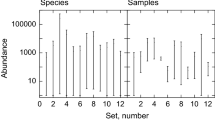Abstract
We present a broad comparative assessment of nested subsets in species composition among ecological communities. We assembled presence-absence data from a broad range of taxa, geographic regions, and spatial scales; and subjected this collection of datasets to common analyses, including a variety of metrics for measuring nestedness and null hypotheses against which to evaluate them. Here we identify ecological patterns in the prevalence and strength of nested subset structure, and assess differences and biases among the available methodologies. In all, we compiled 279 presence-absence matrices, of which 163 do not overlap in their coverage of species and sites. The survey includes studies on vertebrates, arthropods, mollusks, plants, and other taxa; from north temperate, tropical, and south temperate latitudes. Our results were as follows. Statistically significant nestedness was common. Assemblages from landbridge archipelagos were strongly nested, and immigration experiments were least nested. This adds further empirical support to the hypothesis that extinction plays a major role in producing nested structure. Nestedness was positively correlated with the ratio of the areas of the largest and smallest sites, suggesting that the range in area of sites affects nestedness. Taxonomic differences in nestedness were weak. Higher taxonomic levels showed stronger nesting than their constituent lower taxa. We observed no effect of distance of isolation on nestedness; nor any effects of latitude. With regard to methodology, the metrics Nc and Ut yielded similar results, although Nc proved slightly more flexible in use, and deals differently with tied sites. Similarities also exist in the behavior of N0 (“N”) and Up, and between N1 and Ua. Standardized nestedness metrics were mostly insensitive to matrix size, and were useful in comparative analyses among presence-absence matrices. Most metrics were affected by the proportion of presences in the matrix. All analyses of nestedness, therefore, should test for bias due to matrix fill. We suggest that the factors controlling nested subset structure can be thought of as four filters that species pass to occur at a site: a sampling filter, a distance filter, a habitat filter, and an area filter – and three constraints on community homogeneity: evolutionary history, recent history, and spatial variation in the environment. The scale of examination can also have important effects on the degree of nestedness observed.
Similar content being viewed by others
Author information
Authors and Affiliations
Additional information
Received: 13 September 1996 / Accepted: 16 September 1997
Rights and permissions
About this article
Cite this article
Wright, D., Patterson, B., Mikkelson, G. et al. A comparative analysis of nested subset patterns of species composition. Oecologia 113, 1–20 (1997). https://doi.org/10.1007/s004420050348
Issue Date:
DOI: https://doi.org/10.1007/s004420050348




